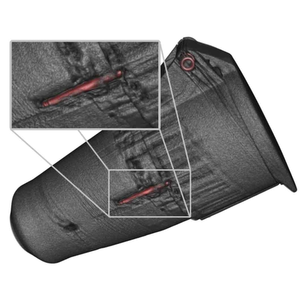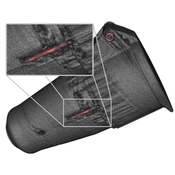Information
- Publication Type: Technical Report
- Workgroup(s)/Project(s):
- Date: May 2007
- Number: TR-186-2-07-06
- Keywords: DECT image fusion, local surface extraction, metrology, Dual Energy CT, dimensional measurement, variance comparison
Abstract
This paper describes a novel method for creating surface models of multi-material components using dual energy computed tomography (DECT). Application scenario for the presented work is metrology and dimensional measurement of multi-material components in industrial high resolution 3D X-Ray computed tomography (3DCT). The basis of this method is the dual source / dual exposure technology using the different X-Ray imaging modalities of a high precision micro-focus and a high energy macro-focus X-Ray source. The presented work aims at combining the advantages of both X-Ray modalities in order to facilitate dimensional measurement of multi-material components with high density material within low density material. We propose a pipeline model using image fusion and local surface extraction technologies: A prefiltering step reduces data inherent noise. For image fusion purposes the datasets have to be registered to each other. In the fusion step the benefits of each modality are combined. So the structure of the specimen is taken from the low precision, blurry, high energy dataset while the sharp edges are adopted and fused into the resulting image from the high precision, crisp, low energy dataset. In the final step a reliable surface model is calculated of the fused dataset, which locally adapts the surface model by moving surface vertices in the direction of the corresponding point normal to a position with maximum gradient magnitude. The major contribution of this paper is the development of a specific workflow for dimensional measurement of multi-material industrial components from high resolution industrial CT data. Several algorithms are extended to take two data sources with complementary strengths and weaknesses into account. The presented workflow is crucial for the following visual inspection of deviations.Additional Files and Images
Weblinks
No further information available.BibTeX
@techreport{TR-186-2-07-06,
title = "Surface Extraction from Multi-Material Components for
Metrology using Dual Energy CT",
author = "Christoph Heinzl and Johann Kastner and Eduard Gr\"{o}ller",
year = "2007",
abstract = "This paper describes a novel method for creating surface
models of multi-material components using dual energy
computed tomography (DECT). Application scenario for the
presented work is metrology and dimensional measurement of
multi-material components in industrial high resolution 3D
X-Ray computed tomography (3DCT). The basis of this method
is the dual source / dual exposure technology using the
different X-Ray imaging modalities of a high precision
micro-focus and a high energy macro-focus X-Ray source. The
presented work aims at combining the advantages of both
X-Ray modalities in order to facilitate dimensional
measurement of multi-material components with high density
material within low density material. We propose a pipeline
model using image fusion and local surface extraction
technologies: A prefiltering step reduces data inherent
noise. For image fusion purposes the datasets have to be
registered to each other. In the fusion step the benefits of
each modality are combined. So the structure of the specimen
is taken from the low precision, blurry, high energy dataset
while the sharp edges are adopted and fused into the
resulting image from the high precision, crisp, low energy
dataset. In the final step a reliable surface model is
calculated of the fused dataset, which locally adapts the
surface model by moving surface vertices in the direction of
the corresponding point normal to a position with maximum
gradient magnitude. The major contribution of this paper is
the development of a specific workflow for dimensional
measurement of multi-material industrial components from
high resolution industrial CT data. Several algorithms are
extended to take two data sources with complementary
strengths and weaknesses into account. The presented
workflow is crucial for the following visual inspection of
deviations.",
month = may,
number = "TR-186-2-07-06",
address = "Favoritenstrasse 9-11/E193-02, A-1040 Vienna, Austria",
institution = "Institute of Computer Graphics and Algorithms, Vienna
University of Technology ",
note = "human contact: technical-report@cg.tuwien.ac.at",
keywords = "DECT image fusion, local surface extraction, metrology, Dual
Energy CT, dimensional measurement, variance comparison",
URL = "https://www.cg.tuwien.ac.at/research/publications/2007/TR-186-2-07-06/",
}


 paper
paper
